A Look At Kansas City’s New Modern Streetcar
Last week leaders in the St. Louis region argued publicly over future pubic transit:
St. Louis Mayor Francis Slay has made clear his support for a north-south MetroLink expansion, saying it’s a top priority in his final year in office. But a recent push for money to plan such a route has met with strong resistance from St. Louis County Executive Steve Stenger.
Stenger, in a letter to the Federal Transit Administration, said he will not endorse the north-south route until other proposed routes are studied. (Post-Dispatch)
At the other end of the state, in Kansas City, there’s also a disagreement about the expansion of rail-based public transit. The local non-profit behind the new KC Streetcar wants to expand South on Main Street, while another is pushing a light rail plan.
[Clay] Chastain argues his plan gives Kansas City residents a real choice and a much more extensive rail transit system, from the airport to the Cerner Trails campus under construction in south Kansas City and from Union Station to the stadium complex.
He estimates it would cost $2 billion to build, or about $45 million per mile, although some light-rail systems have cost considerably more than that per mile. He assumes the federal government would provide $1 billion of that amount.
The local match would come from a 3/8-cent sales tax increase for 25 years, plus 3/8 cents that currently go for the bus system, once that tax expires in 2024. (Kansas City Star)
Anyone who has flown in/out of KC’s airport knows it is a long distance from downtown KC. It’s a 20-25 minute drive, but takes over an hour by bus. Frankly, they need to do both — expand the new streetcar and build light rail to far off destinations like their airport and stadiums.
Kansas City was without rail-based public transit from 1957 until May 6, 2016 — the day the 2.2 mile starter streetcar opened.
THE FUNDING:
- Cost to build: $100 million — $37 million from the federal government, $63 million from bonds.
- Cost to operate: $4 million annually to be paid by a combination of sales & property taxes within the transportation district.
- Fare: $0 — free
- Local comparison: Our Loop Trolley vintage streetcar project. also 2.2 miles long, is costing $51 million to build. The 8-mile cross-county MetroLink extension that opened in 2006 cost $430 million.
THE VEHICLES:
- “Each vehicle is 77 feet and 8 inches long; 78,000 pounds; and 12 feet tall.”
- “Each vehicle capacity is approximately 150 riders and is bi-directional (can run both directions). There is a combination of sitting and standing within the streetcar.”
- “There are three “cars” in each streetcar vehicle, with 4 sets of doors (one on each end and two in the middle car).”
- Each of the four vehicles cost $4.39 million each (source).
- Same as vehicles used in the Cincinnati Streetcar opening later this year.
- Model: CAF Urbos 3 100% low-floor
- Manufactured in Elmira NY by CAF USA, a subsidiary of a Spanish company.
- To meet US crash-standards the body is made of steel
- Comparison: our 4-car light rail vehicles are 90 feet long; capacity of 72 seated plus 106 standing
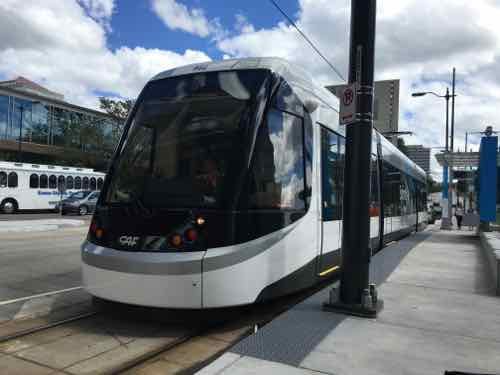
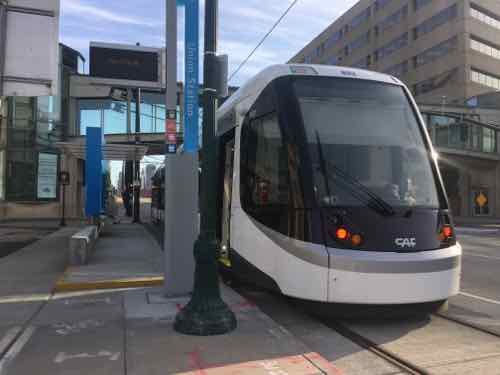
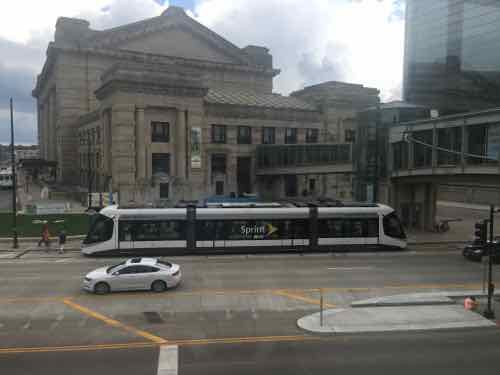
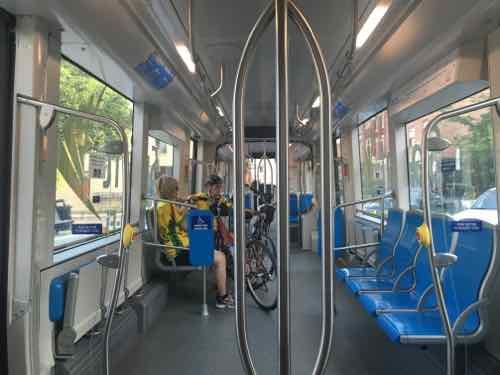
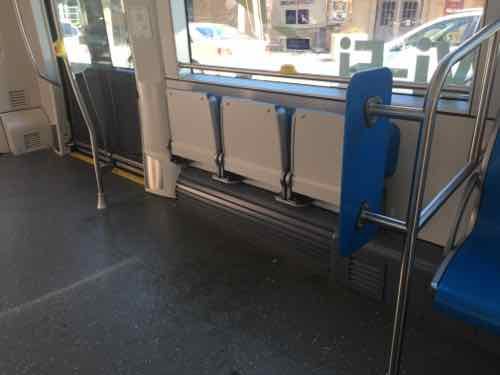
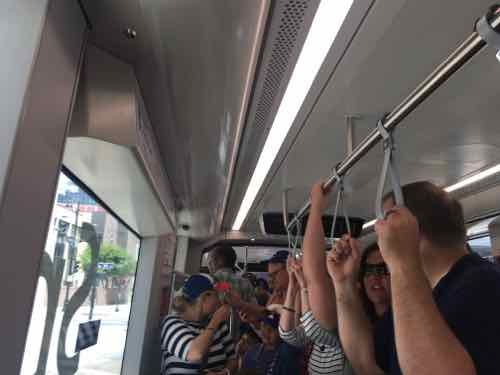
THE ROUTE:
Kansas City is lucky to have Main Street as a central arterial. We have Olive/Lindell, but they’re very different. The 2.2 mile route does a loop on the North end around their River Market area. It goes down Main and ends at Union Station.
The route is 2.2 miles long and travels along Main Street in downtown Kansas City from the River Market to Union Station/Crown Center. The route also includes a loop around the City Market and runs on 3rd St on the north, Delaware on the west, 5th St on the south, and Grand on the east. (KC Streetcar FAQ)
An extension to continue South on Main Street is already being planned.
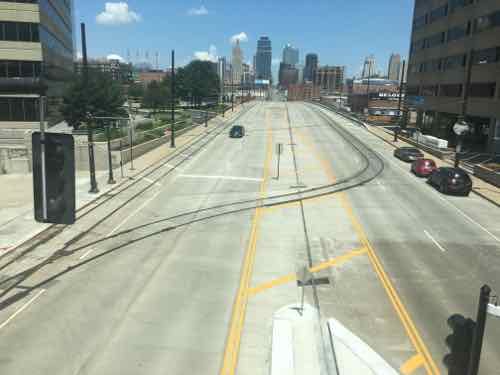
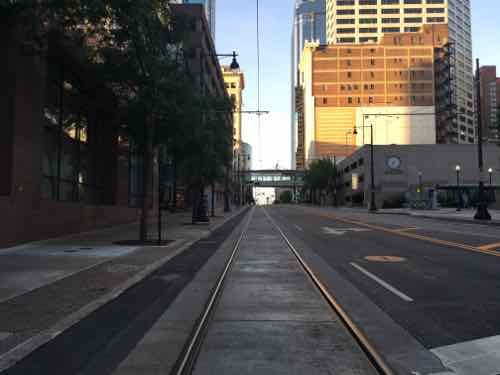
See a route map here.
THE STOPS:
Stops are every few blocks, over the 3-day weekend I rode the streetcar a few times but also traveled the route on the sidewalk. For the most part. the stops are built out into the parking lane — leaving the sidewalk unblocked.
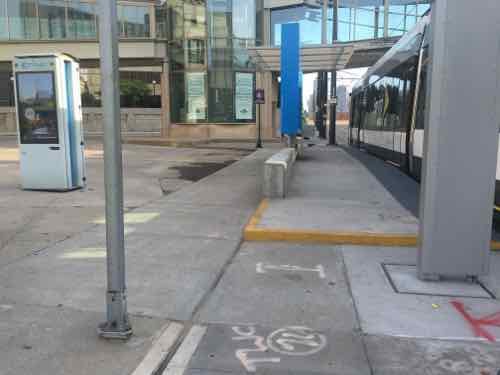
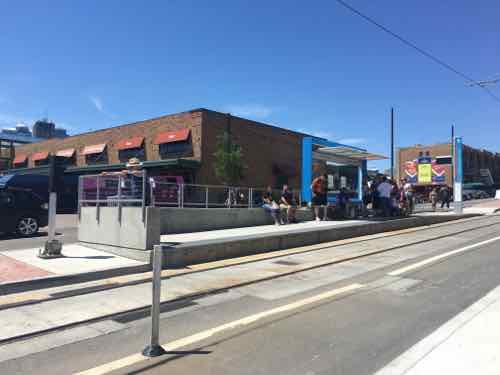
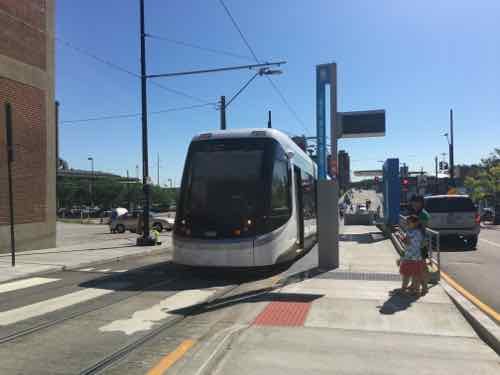
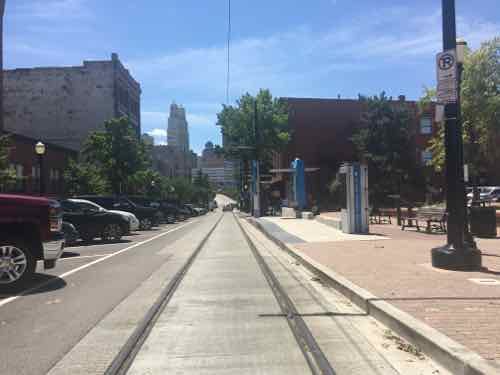
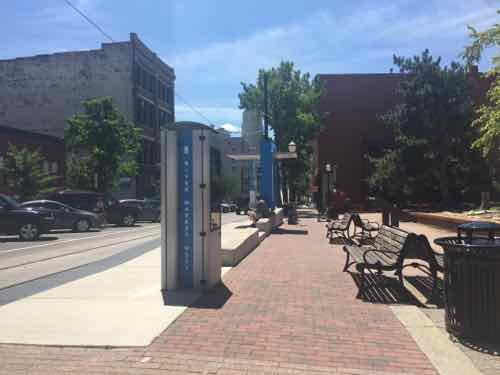
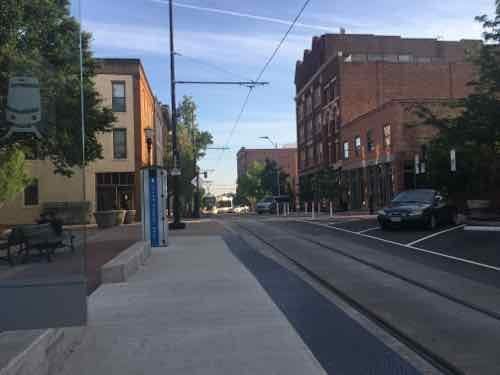
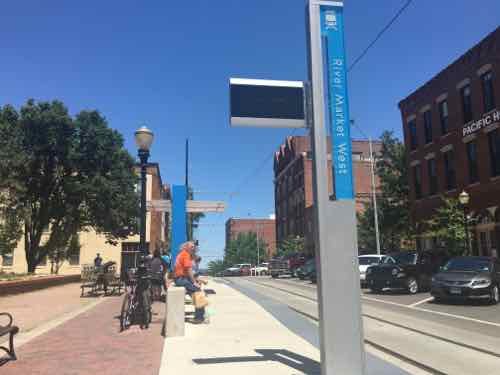
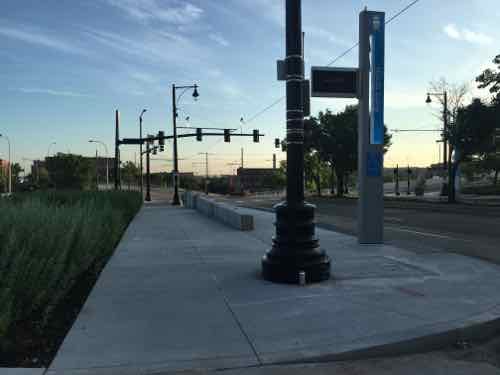
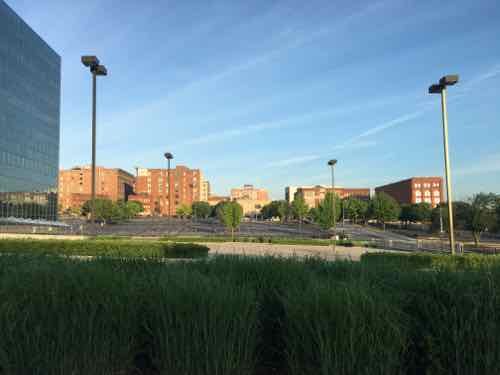
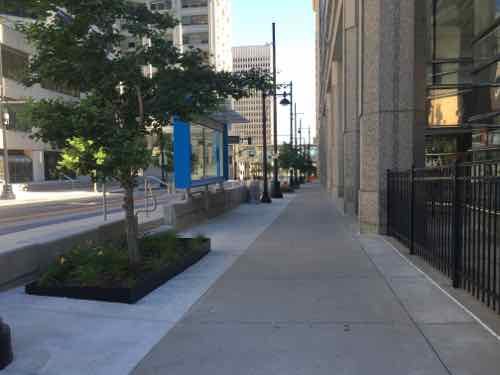
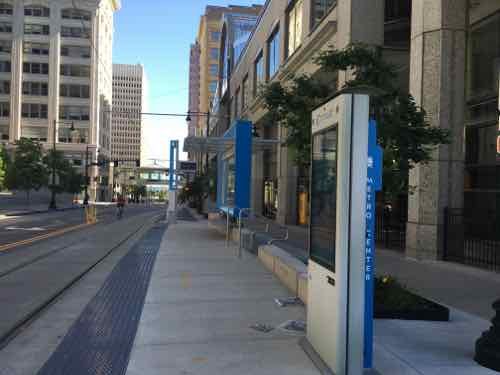
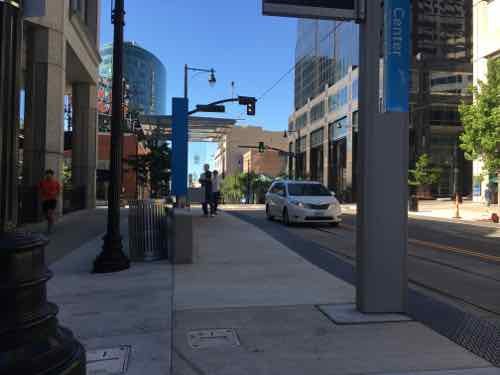
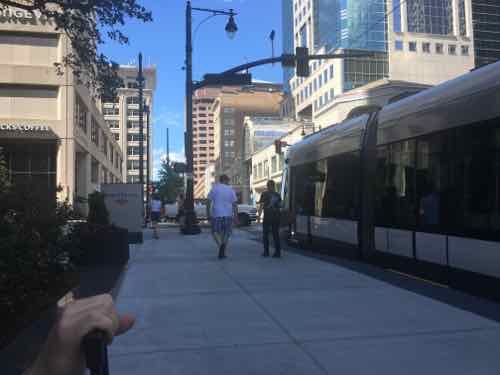
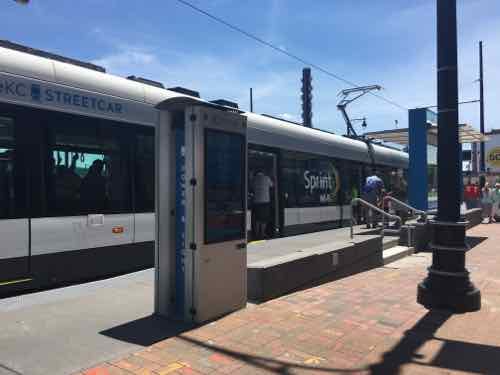
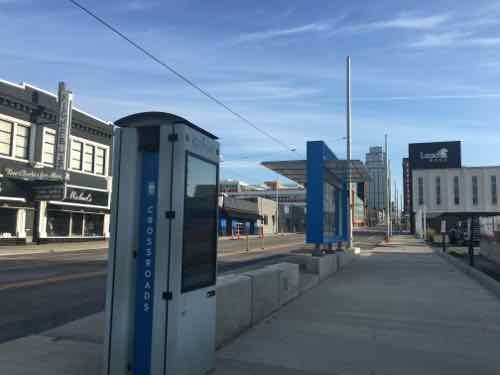
NEW CONSTRUCTION:
New construction is everywhere in Kansas City, especially near the streetcar route.
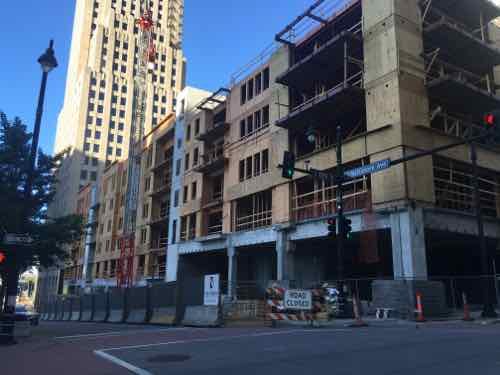
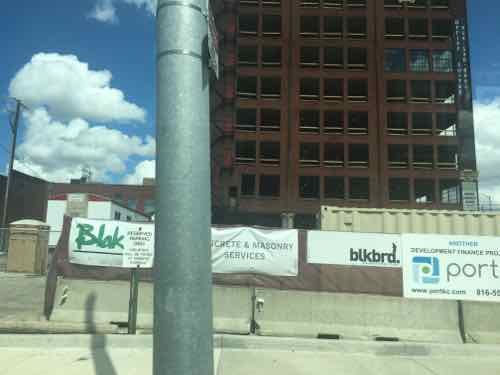
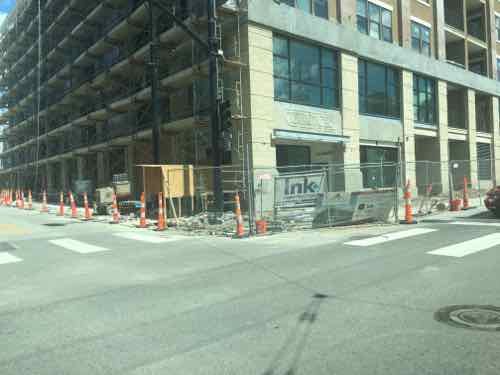
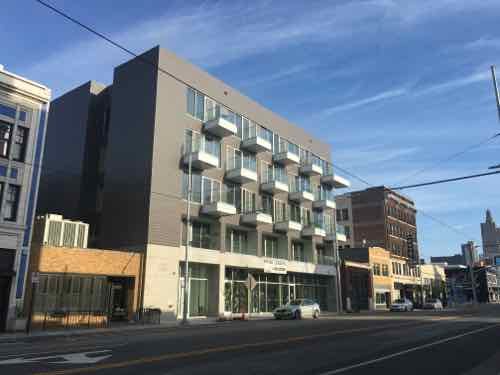
VIDEO:
I put together a brief video of various clips I took:
FINAL THOUGHTS:
Their streetcar isn’t meant to be a regional system, at least not initially. CAF makes very similar vehicles for use in higher-speed light rail applications, so if they ever do a light rail line the vehicles could look just like their streetcar.
The main problem we experienced was crowds — but it was a nice holiday weekend in the first month of service. Would like to ride it on a regular weekday. We did speak to a retired couple that recently moved from the suburbs to new construction downtown — the streetcar was one reason,
Being right there it helped add life to the street. It’ll be interesting to see if they’ll be able to expand.
— Steve Patterson
So, it’s going to cost the taxpayers $11,000 a day to operate the line? What did the bus line that it’s partially replacing cost to operate?! And why NOT charge fares? Since it’s “better” than a bus?!
This is a bargain compared to the $12 million Denver taxpayers spend annually to operate free shuttle buses on 16th Street.
And the ridership numbers for the two routes are?
Denver’s 16th Street has had shuttles since 1982, expanded a couple of times to 1.25 miles. KC’s 2.2 mile streetcar has only been open since May 6th — many new residential buildings are still under construction, others are planned.
At this point it would be impossible to accurately compare ridership. Denver’s serves a very limited area — costing $9.6 million per mile to operate. Kansas City will spend $1.8 million per mile to operate. I’m sure if Kansas City taxpayers spent 5x more per mile of operations they could increase frequency and ridership.
I agree, with a lot more money “they could increase frequency”; I doubt that they can increase ridership to match Denver, unless and until they get the same densities along the line. Bigger picture, I still have a major problem with spending $100 million (in capital costs) plus another $4 million a year (in operating costs) to operate 3 vehicles every 15-20 minutes, essentially doing the exact same thing that buses were doing for less than $2M or $3M a year! Just because you can does not mean that you should! . . . http://www.govtech.com/fs/Is-it-Still-Worth-it-to-Build-Street-Cars.html
The Max bus line didn’t get the ball rolling on new infill construction the way the streetcar has.
And it’s not the government’s role to be spending millions of dollars to “get the ball rolling on infill construction”, when spending less money on more buses offering greater frequncies over a far more robust route structure would yield far greater return on investment!
The residents & property owners within this district voted to tax themselves. Government has long played a role in development — notably suburban highways that encouraged automobile use that drained cities of people and destroyed them for parking. This is just a fraction in the other direction.
I get all that – I just disagree with spending tens of millions of dollars to do something with tax dollars that can be done just as well for far less money. Streetcars are just buses that run on rails. Yes, they have some minor aesthetic advantages over buses, but they are certainly NOT worth 8-10 times more than buses! Look at Denver – their transit mall uses buses; yes, custom made ones, that get the job done and move 50,000 people a day, and has, successfully, for decades! KC has just bought into the Pearl District hype, where a booming economy corresponded with a streetcar going in, and the rail wonks made the leap to streetcar = development. If that were the case, Kenosha, Memphis and Tampa would all have seen booming infill development along their lines, just like we’re being promised along Delmar.
Transit is one small part of urban (re)development, no different than sidewalks, parking and landscaping, but no one has the resources to replace every bus with a rail-based vehicle to help every developer. Rail, both light and heavy, is very good at moving large numbers of riders over longer distances. Putting a bigger-than-bus-sized vehicle in the middle of urban traffic, on rails, while making it *potentially* nicer for the riders who choose to use it, does very little to convince developers to invest in infill (otherwise neither the Cortex nor the Loop would be where they are today, because, duh, there was no streetcar happening in either place when they were first taking off!).
Development relies on many parts falling into place – financing, demand, demographics, migration patterns, transportation (in all forms), parking, taxes, available land, land costs, construction costs, etc, etc. No streetcar will ever make or break any development, it’s just another amenity that a developer can offer while spending everyone else’s money (and not his own!), no different than a pool, parking or a workout room. The big difference is that the developer gets to pay for all those other amenities (to lavish on his consumers), but everyone expects the “taxpayers” to pick up the tab for the streetcar!
And don’t get me wrong, I support GOOD public transit. I just see little point in spending(wasting?) large sums of money on something that needs to be “free” to inflate ridership numbers, when the previous bus route was doing just fine charging fares and plodding along in the right lane. No different than the folks who regret voting for Brexit, I suspect that there are plenty of KC voters who are questioning their vote to support this boondoggle . . .
Kansas City bought 4 streetcar vehicles to start. Now that ridership is beyond expectations they’re looking at adding a 5th. Another vehicle will allow them to increase frequency. The life expectancy on modern streetcars is 30 years.
Denver’s 36 new shuttle buses, that cost taxpayers $27 million, are expected to last only 12.
You continue to think demand just happens organically — it doesn’t. Never has. Government policy created demand for auto-centric suburbs. Now, because that is no longer sustainable, government policy is making tiny attempted to level the playing field. Get over it.
Kansas City paid “$4.39 million per vehicle” for their streetcars. Denver is paying $750,000 for each of their new buses, that, yes, will last about 12 years, just like the first two batches. So, for comparison’s sake, let’s pay for them 3 times (to get us up to 36 years) – that brings the cost up to $2.25 million to procure “enough” vehicles, still HALF the cost of a streetcar (in present-day dollars)! And Denver’s 36 buses allows their RTD to run a very robust schedule, as frequently as every 70 seconds during rush hour (compared to every 10 minutes in KC).
Yes, it does take investments to create demand. When it comes to demand for transit, the biggest argument I hear against using it is that it takes too damn long to get most places using public transit. People can get past the fact that they have to wait someplace in public for the vehicle to show up, and they can get past the fact that they have to share the vehicle with people who aren’t always quite like them, but most people are not willing to give up an hour or two out of their lives, every day, to use transit, if they don’t have to!
That reality comes primarily from the combination of having a weak route structure and low frequency. Putting wildly-more expensive vehicles on ANY route WILL improve the rider experience on that route. Making transit “free” to board and ride WILL attract more riders. But putting a more expensive vehicle in city traffic will NOT improve frequency, yet it WILL starve all the other routes of the resources to make incremental improvements over a much broader area.
Where you and I differ on this issue is that you view transit as a development tool, while I view it as a way to move people. I have no problem with directing public resources to improving public transit IF the goal is to improve service, system wide, which will, in turn, attract more riders and serve them better. I have a big problem with the public spending $100 million along one 12,000 foot long corridor so that some developers can have an easier time marketing their projects. If they want to do that, let them each cough up $5M or $10M, each, and build whatever they want.
Denver’s Mall Shuttle is an integral part of their larger transit system. It allows buses to operate more efficiently outside of the CBD while solving that last-mile question for a whole bunch of people. The KC Streetcar, along with our Loop Trolley, does/will do little to improve transit outside its very specific corridor, and appears to be aimed more at serving tourists than daily commuters.
As for “exceeding projections”, the KC Streetcar said on June 13th that “more than 250,000 people have boarded since opening day [on May 6th] . . . the KC Streetcar has had a daily average ridership of 6,435.”. That’s 5 weeks, including the first weekend, when there was incredible demand (27,000+, not surprisingly). Yes, that exceeded their original estimate; the question is can that demand be maintained. And, interestingly, demand is far higher on the weekends than it is during the week: “As of this published date, the KC Streetcar has had a daily average ridership of 6,435. Break that down to the weekend average ridership (Saturdays & Sundays), that average is 9,554.” What remains unsaid is that weekday ridership 5,187, which is still higher than the 2,700 originally projected.
I’ve been visiting KC for more than 30 years, the MAX bus was ok but it wasn’t transformative the way the streetcar has been. As a disabled rider — the two are night & day different. I think KC made the right decision! The St. Louis region could learn so much from Kansas City — from how to do new infill construction to transit that activists streets.
Could learn. Won’t. Government is *very* different in Kansas City.
St. Louis is balkanized; most of the little city governments are beyond corrupt and well into “fiefdom”, with petty and thieving local governments and endless bigotry.
Kansas City is centralized and industrialists with inherited wealth and a particular philosophy of development control it pretty much absolutely.
Neither situation is ideal, but the St. Louis region will definitely refuse to learn from KC. Maybe some other city will — Omaha, perhaps, which has similar political dynamics to KC.
What I keep saying – actual transit riders value frequency, speed and walkability far more than any specific type of vehicle: http://www.citylab.com/commute/2016/07/transit-riders-survey-walkability-frequency-speed/490913/